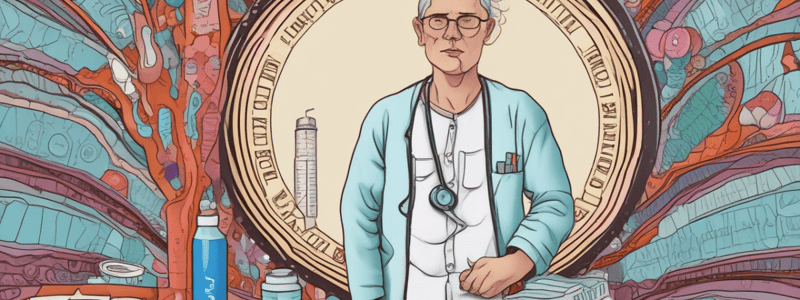Podcast
Questions and Answers
What percentage of patients with IDDM will experience renal failure?
What percentage of patients with IDDM will experience renal failure?
- 50-60%
- 30-40% (correct)
- 70-80%
- 10-20%
What is the result of increased thickness of capillary basement membrane?
What is the result of increased thickness of capillary basement membrane?
- Compromised blood flow (correct)
- Decreased blood pressure
- Increased blood flow
- Increased oxygen delivery
What is the name of the disease characterized by end-stage renal disease and chronic renal failure?
What is the name of the disease characterized by end-stage renal disease and chronic renal failure?
- Diabetic nephropathy
- Diabetic retinopathy
- Kimmelstiel-Wilson disease (correct)
- Diabetic neuropathy
What is the result of diabetic neuropathy on nerve proteins?
What is the result of diabetic neuropathy on nerve proteins?
What is the type of diabetic retinopathy characterized by scattered microaneurysms and dot haemorrhages?
What is the type of diabetic retinopathy characterized by scattered microaneurysms and dot haemorrhages?
What is the result of uncontrolled new vessel growth in diabetic retinopathy?
What is the result of uncontrolled new vessel growth in diabetic retinopathy?
What is the term for the narrowing of blood vessels in diabetic retinopathy?
What is the term for the narrowing of blood vessels in diabetic retinopathy?
What is the result of diabetic neuropathy on muscle function?
What is the result of diabetic neuropathy on muscle function?
What is the term for the progressive accumulation of basement membrane in diabetic glomerulosclerosis?
What is the term for the progressive accumulation of basement membrane in diabetic glomerulosclerosis?
What is the result of diabetic nephropathy on glomerular filtration rate?
What is the result of diabetic nephropathy on glomerular filtration rate?
What is the primary consequence of reduced tissue sensitivity to insulin?
What is the primary consequence of reduced tissue sensitivity to insulin?
Which diabetic complication is directly related to the severity and duration of hyperglycemia?
Which diabetic complication is directly related to the severity and duration of hyperglycemia?
What is the mechanism by which hyperglycemia leads to vascular damage?
What is the mechanism by which hyperglycemia leads to vascular damage?
Which acute complication of diabetes is characterized by unconsciousness and is more common in IDDM patients?
Which acute complication of diabetes is characterized by unconsciousness and is more common in IDDM patients?
What is the effect of hyperglycemia on the immune response?
What is the effect of hyperglycemia on the immune response?
Which diabetic complication is characterized by shaking, sweating, rapid heartbeat, and hunger?
Which diabetic complication is characterized by shaking, sweating, rapid heartbeat, and hunger?
What is the primary cause of diabetic neuropathy?
What is the primary cause of diabetic neuropathy?
Which of the following is a consequence of increased polyol pathway activity?
Which of the following is a consequence of increased polyol pathway activity?
What is the primary action of insulin on the body?
What is the primary action of insulin on the body?
What is the characteristic of Type I diabetes mellitus?
What is the characteristic of Type I diabetes mellitus?
What is the effect of insulin on the liver?
What is the effect of insulin on the liver?
What is the characteristic of Non-Insulin-Dependent Diabetes Mellitus (NIDDM)?
What is the characteristic of Non-Insulin-Dependent Diabetes Mellitus (NIDDM)?
What is the result of uncontrolled hyperglycemia?
What is the result of uncontrolled hyperglycemia?
What is the action of glucagon on blood glucose levels?
What is the action of glucagon on blood glucose levels?
What is the complication of uncontrolled diabetes mellitus?
What is the complication of uncontrolled diabetes mellitus?
What is the effect of insulin resistance on the body?
What is the effect of insulin resistance on the body?
What is the characteristic of Gestational Diabetes?
What is the characteristic of Gestational Diabetes?
What is the role of sulfonylureas in the treatment of diabetes mellitus?
What is the role of sulfonylureas in the treatment of diabetes mellitus?
What percentage of all cancers have a mutation in the Rb gene?
What percentage of all cancers have a mutation in the Rb gene?
What is the economic cost of cancer in the UK per annum?
What is the economic cost of cancer in the UK per annum?
At what age does the incidence of cancer increase drastically?
At what age does the incidence of cancer increase drastically?
What is the lifetime risk of cancer in females?
What is the lifetime risk of cancer in females?
What percentage of cancers in children are epithelial carcinomas?
What percentage of cancers in children are epithelial carcinomas?
What percentage of cancers in adults are attributed to epithelial carcinomas?
What percentage of cancers in adults are attributed to epithelial carcinomas?
What is the percentage of cancers in adults attributed to basal and squamous cell carcinomas?
What is the percentage of cancers in adults attributed to basal and squamous cell carcinomas?
What percentage of UK deaths are attributed to cancer?
What percentage of UK deaths are attributed to cancer?
What is the characteristic of cancers with high survival rates following treatment?
What is the characteristic of cancers with high survival rates following treatment?
What is the most common primary intraocular malignancy?
What is the most common primary intraocular malignancy?
What is the characteristic of malignant choroidal melanomas?
What is the characteristic of malignant choroidal melanomas?
What is the characteristic of retinoblastoma?
What is the characteristic of retinoblastoma?
What is the survival rate of people with certain types of cancer?
What is the survival rate of people with certain types of cancer?
What is the characteristic of iris nevi?
What is the characteristic of iris nevi?
What is the characteristic of choroidal nevi?
What is the characteristic of choroidal nevi?
What is the age range most affected by melanoma?
What is the age range most affected by melanoma?
What is the primary mechanism by which cancer cells exit the circulation and arrive at the site where they will form a new secondary deposit?
What is the primary mechanism by which cancer cells exit the circulation and arrive at the site where they will form a new secondary deposit?
What is the minimum size required for a tumour to survive and grow as a metastases?
What is the minimum size required for a tumour to survive and grow as a metastases?
Which of the following growth factors do tumour cells secrete to stimulate new vessel growth by angiogenesis?
Which of the following growth factors do tumour cells secrete to stimulate new vessel growth by angiogenesis?
What is the term for the formation of new blood vessels, which is necessary for tumour growth?
What is the term for the formation of new blood vessels, which is necessary for tumour growth?
What is the critical stage in the development of invasive carcinoma where the tumour has to grow greater than 0.05 mm?
What is the critical stage in the development of invasive carcinoma where the tumour has to grow greater than 0.05 mm?
What is the purpose of treating a metastases with inhibitors against angiogenesis or tissue targeting?
What is the purpose of treating a metastases with inhibitors against angiogenesis or tissue targeting?
What is the process by which cancer cells are able to avoid detection by the immune system until they arrive at the site where they will form a new secondary deposit?
What is the process by which cancer cells are able to avoid detection by the immune system until they arrive at the site where they will form a new secondary deposit?
What is the term for the new secondary deposit that forms when cancer cells exit the circulation and arrive at a new site?
What is the term for the new secondary deposit that forms when cancer cells exit the circulation and arrive at a new site?
Flashcards are hidden until you start studying
Study Notes
Respiratory Infections and Diabetes
- Necrobiosis lipoidica diabeticorum is a severe necrobiosis that occurs mostly in women, leading to ulceration and chronic complications.
- Diabetic microvascular disease can lead to diabetic neuropathy, nephropathy, cardiomyopathy, and retinopathy.
- Atherosclerotic lesions can cause blood vessel occlusion, leading to cardiovascular disease, coronary artery disease, and peripheral vascular disease.
- Diabetic foot complications can include ulcers, gangrene, and ischaemia.
Diabetic Microvascular Disease
- Increased thickness of capillary basement membrane and arteriolosclerosis can lead to vascular occlusion and compromised blood flow.
- Defective healing in chronic ulcers can occur due to diabetic microvascular disease.
- Major complications can occur in the kidney and retina, including nerve damage and collagen, smooth muscle cell, and fibroblast dysfunction.
Diabetic Nephropathy
- Renal failure occurs in 30-40% of IDDM patients and a few NIDDM patients, increasing with severity and duration.
- Necrotising papillitis and diabetic glomerulosclerosis can lead to papillary necrosis and end-stage renal disease.
- Kimmelstiel-Wilson disease is a type of diabetic glomerulosclerosis that can lead to end-stage renal disease and chronic renal failure.
Diabetic Neuropathy
- Disease duration is a major factor in diabetic neuropathy, with 40% of patients developing neuropathy after 20 years.
- Pathology includes thickened capillaries, ischaemia, glycosylated nerve proteins, axonal degeneration, and loss of myelination.
- Symptoms include decreased sensation, muscle weakness, atrophy, and wastage.
Diabetic Retinopathy
- Microaneurysms, haemorrhage, and exudates can occur in diabetic retinopathy, leading to sight-threatening complications.
- Proliferative diabetic retinopathy is a severe form of diabetic retinopathy that can lead to visual loss.
- Background diabetic retinopathy can include scattered microaneurysms, ischaemic, and dot haemorrhages.
Diabetes
- Diabetes is a metabolic disorder characterized by impaired insulin secretion and reduced tissue sensitivity to insulin.
- Environmental factors, such as obesity and hypertension, can contribute to the development of diabetes.
- Insulin resistance and hyperglycemia can lead to protein glycosylation and vascular basement membrane thickening.
Acute Complications
- Hypoglycemia can occur in 30% of IDDM patients, leading to unconsciousness and other symptoms.
- Ketoacidosis is a severe complication of diabetes that can lead to death in 2.5% of cases.
- Hyperosmolar non-ketoacidotic coma is a severe complication of diabetes that can lead to death in 15% of cases.
Chronic Complications
- Chronic hyperglycemia can lead to disordered metabolism, major vascular complications, and specific microvascular complications.
- Diabetic complications can be caused by the severity and duration of hyperglycemia, as well as the level of glycaemic control.
Pancreas
- The pancreas produces insulin and glucagon, which regulate blood glucose levels.
- The Islet of Langerhans produces insulin, glucagon, and other hormones that regulate blood glucose levels.
Insulin
- Insulin is produced by the pancreas and regulates blood glucose levels by facilitating glucose entry into cells.
- Insulin binding to receptors leads to the release of second messengers, which facilitate glucose entry into cells.
Classification of Diabetes
- Diabetes can be classified into insulin-dependent (type I) and non-insulin-dependent (type II) diabetes.
- Gestational diabetes, malnutrition-related diabetes, MODY, and secondary diabetes are other types of diabetes.
Pathogenesis and Treatment
- IDDM is caused by genetic predisposition, autoimmune destruction of beta cells, and environmental factors.
- NIDDM is caused by multifactorial inheritance, downregulation of insulin receptors, and reduced response to insulin.
- Treatment of diabetes includes insulin injections, dietary management, and oral hypoglycaemic agents.
Insulin-Dependent Diabetes (Type I)
- Juvenile onset, sudden, and severe onset of diabetes
- Normal body weight and energy
- Hyperglycemia, glycosuria, and fluid and electrolyte imbalances
Non-Insulin-Dependent Diabetes (Type II)
- Maturity onset, gradual, and subtle onset of diabetes
- Overweight, familial, and normal/slightly reduced beta cells
- Normal blood insulin levels
Studying That Suits You
Use AI to generate personalized quizzes and flashcards to suit your learning preferences.



